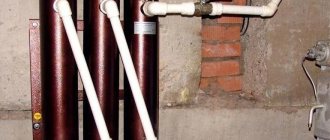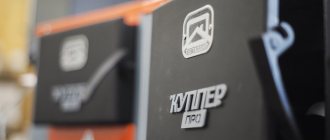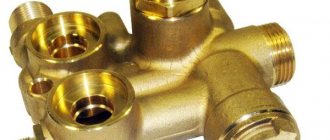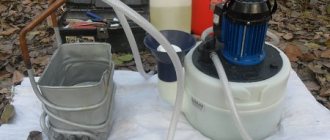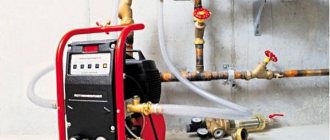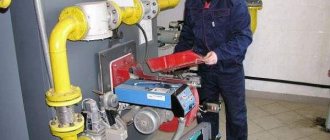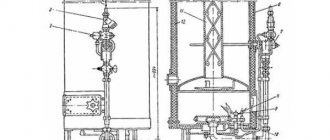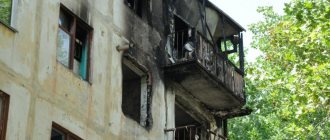The selection of a boiler for any production must be carried out after preliminary calculations. The parameters of the operation of the unit itself are calculated, its functional features (power, type of energy resource or coolant) are taken into account. It is important to know the size of the room in each of the buildings owned by the enterprise (for example, each workshop is taken into account), the number of seasonal days for heating, the desired consumer outlet temperature, etc. Only after taking into account all the nuances can you start choosing a boiler.
Selection by fuel type
Gas is a low-cost and less expensive product that provides useful energy. But it also has its own combustion products. Therefore, it is imperative to make a separate pipe to remove the fumes outside (outside the building) from the boiler. There are two options for boiler houses using this raw material:
- With connection to central highways;
- Using cylinders.
In the first case, the condition is quite simple. There is a gas pipeline running nearby - you can easily connect a boiler to heat the enterprise. No - then either cylinders are used or this type of combustible material is abandoned altogether.
The reason for switching to another energy resource is a significant factor - the laying and installation of gas pipeline pipes connected to central pipelines will cost the company too much. And using gas in cylinders is not an option. The purchase of liquefied raw materials, a separate storage for it - all this is too expensive in terms of money. The conclusion is the following - the boiler for production should be installed on gas where there is a main consumer passage nearby.
- Diesel is a liquid fuel that is not always affordable for an enterprise. It is usually required in large quantities, and the designs of the units do not always provide for the loading of liquid media into the combustion chamber. But if such models are sold on the market, then they should be looked at with special care. The outlet of the pipe with combustion products is required. It is also necessary to equip a separate hangar for storage of tanks. It is necessary to exclude as much as possible the spontaneous combustion that may occur accidentally.
Solid fuel materials also always require a separate warehouse. Among these types of raw materials, the following options are usually used.
- Firewood is also one of the cheapest combustible materials to purchase. But here you should definitely look at what types of trees the wood should be used specifically for technical boilers. Usually these are high-density, less loose options. Not like pine, but like oak. Birch firewood is most often used in everyday life, and not for industrial boiler rooms.
- Pellets (briquettes, granules) are classified as derivatives of wood fuel materials. They are made by pressing from different types of waste from the woodworking process. Unfortunately, among them there are a lot of specimens that contain resins and chemicals. They end up in briquettes after processing chipboard, ODSPA, fiberboard and other materials, where laminate and other materials are found. This factor suggests that various inclusions in the fuel can ruin the entire boiler system, severely and frequently polluting it. You will have to clean the smoke passages too often.
- Coal is a solid fuel type of energy resource that has been used for a long time for various types of boilers. He has his own brands and varieties. For example, “AK” is not suitable for use in boiler houses, even though it is the most expensive coal. To create your own boiler room using such material as a source of ignition and heating, you need to prepare a place where the coal will be stored all winter. Today there are boilers on sale that have an automatic receiver control where coal is loaded into the combustion chamber.
Use of various boilers in production:
Coolant for boiler
In many ways, installation with connection to the heating system itself plays a large role in the selection of the installation. The key element in the systems is the coolant, which is received by the boiler, subjected to heating, and then released to flow through pipes and radiators. At such points of consumption, the heated agent gives off heat directly to the radiators and pipes, which heat the room.
Industrial models can be universal in terms of receiving and processing a specific coolant with thermal energy. But for industrial use, there are often boilers that can accept only one type of coolant. The choice is usually presented between three main types of liquid distillation medium:
- Water.
- Antifreeze.
- Propylene glycol.
Inhibitor mixtures are also added to such liquids to maximally neutralize the aggressiveness of media flowing through metal pipes. This is done to avoid metal corrosion. When using plastic pipes, such means are necessary to eliminate scale. This is especially true for water or steam.
Application area
All heating and hot water boilers of industrial type are used in various industries and agriculture. Some of them are used to organize heating systems in villages and complexes (residential and non-residential).
Typically, an industrial heater installed at a factory immediately solves all the tasks related to heat and production technology. That is, it works for the heating system, hot water supply, and for technical purposes related to the production of certain products.
Fuel calculation per 1000 sq.m.
In order to correctly calculate what power a boiler should be installed to service an enterprise, you should take into account the general heat loss indicators, which are accepted as the standard. It is very important that the building itself is well insulated. For example, we can consider a room with a volume of 5500 cubic meters. and an area of 1000 sq.m. In such a space, the heat loss will be as follows:
15.3 kW will go through the roof;
- 7.4 kW – walls;
- 5.2 kW – windows;
- 10.8 kW – floor;
- 0.5 kW – door.
Using calculators, you can achieve quite serious calculation results suitable for use in the design of heating systems for a specific facility. Let's look at an example in a special table of how to calculate per 1000 sq.m. area consumption of one or another fuel. The input data for the calculator will be as follows (warehouse):
- The area of space for heating is 1000 sq.m.
- Ceiling height – 3 m.
- Thermal insulation – 100%.
- The desired optimal temperature inside (on average) is 22˚C.
- The duration of the season is 180 days.
- The minimum required boiler power is 68.39 kW.
- The boiler power that a specialist would recommend is 70-75 kW.
| Energy resource type | Flow volume | price, rub. | Total costs for a season of 180 days, rub. | ||
| Qty | Unit change | Sum | Unit change | ||
| Firewood (oak) | 89,20 | cubic meters | 1100 | cubic meters | 98 120 |
| Pellets (briquettes or granules from compressed shavings) | 31,72 | T | 4840 | 1 t | 153 524 |
| Natural gas (for legal entities) | 15858,37 | cubic meters | 20,9 | cubic meters | 331 440 |
| Natural gas (for housing and communal services, heating of the population) | 15858,37 | cubic meters | 15,4 | cubic meters | 244 220 |
| Diesel fuel | 10,21 | l/h | 10,03 | 1 l | 235 598 |
| 32000 | l/year | ||||
| Coal (brown) | 32 | t/year | 3,5-6 | 1 kg | 176 000 – 192 000 |
| 5500-6000 | 1 t | ||||
| Electricity (for legal entities) | 114180,23 | kW-hh | 3,3 | kW-hh | 376 795 |
| Electricity (for housing and communal services) | 114180,23 | kW-hh | 1,1 | kW-hh | 125 598 |
Conclusions - which energy resource is most beneficial for boiler companies
Approximate financial waste (on average) for seasonal heating of a room of 1000 sq.m. taking into account different prices on the market, if you heat:
- Coal (brown) – 192 thousand rubles.
- Pellets – up to 434 thousand rubles.
- Oak firewood – 110 thousand rubles.
- Diesel – 710 thousand rubles.
- Gas (natural) – 130 thousand rubles.
- Electricity – up to 420 thousand rubles.
After the reviewed reviews, the following conclusion suggests itself - the most profitable in terms of money spent are solid fuel boilers. The savings consist of reduced cash costs when purchasing raw materials, as well as slow combustion in order to obtain the maximum required efficiency.
But their advantages are obvious only when mechanical heat loss is minimized. And to do this, before installing and starting up the boiler room, you must first insulate the building itself well. In addition, pellets are too expensive to use for heating industrial premises.
Introduction
This instruction is written to help those people who are faced with the question of choosing a boiler for heating a room. has been producing and supplying heating boilers for 9 years, and during this time has accumulated considerable experience on this issue. Our boilers are installed in more than 10,000 premises throughout Russia and in the near abroad. In this manual, we will try to describe the process of selecting a boiler as clearly and completely as possible, while making it easy enough to understand. In addition to the issues of selecting a boiler for different premises - private houses, industrial buildings, greenhouses, drying chambers - we will consider additional issues that you should pay attention to when choosing a boiler. IMPORTANT! This instruction allows you to satisfy most requests for boiler selection. At the same time, there are situations when the production process (for example, for growing a certain type of plant, obtaining wood of a certain degree of moisture) requires a stable set temperature throughout the entire operation. In this case, the materials in this manual may not be enough. We strongly recommend that you contact specialized organizations for a full thermal calculation of your premises.
TOP 3 models - description of boilers with characteristics and prices
As an example, we can consider several options for the most optimal boiler installations for heating industrial buildings, premises and areas.
Kirov plant, KChM-5-K-03M1, combined
- The material of the body and combustion chamber is cast iron.
- Power – 70 kW.
- Heat influence area – 700-1000 sq.m.
- Combustible materials – firewood, briquettes (peat), coal, diesel, fuel oil, waste oil, gas.
- Coal consumption (for example) – 10.6 kg/h.
- Chamber design – 8 sections for solid fuel.
- Burner – can be installed additionally.
- The type of heat exchanger is single-circuit.
- Efficiency – 79.8%.
- Coolant temperature – up to +95˚С.
- Water pressure in the circuit (max.) – 4 bar.
- Combustion chamber type – open.
- Installation method: floor.
- Chimney diameter – 203 mm.
- Dimensions (WxHxD) – 505x1150x1430 mm.
- Assembly weight – 568 kg.
- The cost of the equipment is 99,000 rubles.
- Manufacturer – Russia.
Kiturami KSG-70R, gas

- Material – cast iron, thick sheet steel.
- Power – 82 kW.
- Heating area – 2300 sq.m.
- Hot water supply – yes (from 30 l).
- Combustible materials – natural gas.
- Gas pressure – 100-250.
- The pressure in the circuit is up to 3.5 kg/cm.
- The burner is turbocyclone.
- The type of heat exchanger is double-circuit.
- Additional devices - pressure sensors, thermostat, temperature controller, etc.
- Productivity – 90%.
- Installation method: floor.
- Dimensions (HxWxD) – 1280x580x900 mm.
- The weight of the structure is 200 kg.
- The average cost of equipment is 178,500 rubles.
- Country of origin: Korea.
CTC, Wirbex 70
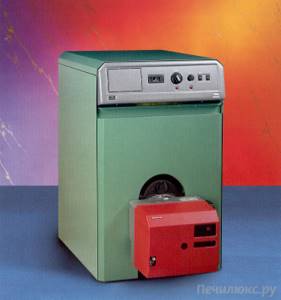
- The material of the body and combustion chamber is cast iron.
- Power – 72.3-80 kW.
- Heat influence area – 800-1200 sq.m.
- Combustible materials – gas, diesel.
- The type of heat exchanger is single-circuit.
- Heat transfer coefficient – 90.4%.
- Coolant temperature – up to +92˚С.
- Combustion chamber type – open.
- Installation method: floor.
- Chimney diameter – 150 mm.
- Additionally – remote control and connection (40 mm).
- Dimensions (HxWxD) – 920x600x830 mm.
- Product weight – 256 kg.
- The cost of the equipment is 136,500 rubles.
- Manufacturer – Sweden.
Boiler systems for long-burning enterprises are, as a rule, solid fuel or universal modifications. The former use wood, coal or gas as an energy resource. The latter can accept any type of fuel into the combustion chamber, which will be their versatility. An economical coal or wood boiler can have a design that allows it to release heat for as long as possible and with a minimum of loading (acceptance of flammable material for processing).
Specifications
To understand the technical characteristics of industrial heaters, we will consider two brands of this equipment: one European, the other domestic. Europe will be represented by the Viessmann concern of the Netherlands, Russia by the Yekaterinburg AGUNA plant with its STG-Classic boiler.
Viessmann
The European concern produces two types of industrial boiler equipment: hot water boilers and steam boilers. The power of water heating units is a wide range from 18 to 40 kW. There are 9 standard sizes in this range. The maximum coolant temperature can be increased to +200 °C. At the same time, its maximum pressure is up to 39 atm.
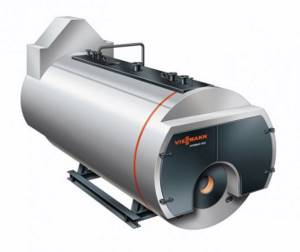
Steam analogues have a steam capacity from 18 to 60 t/h. There are 13 standard sizes. Steam pressure – up to 39 atm. Temperature – up to +400 °C. These units have an overheat control unit installed, which immediately turns off the boiler.
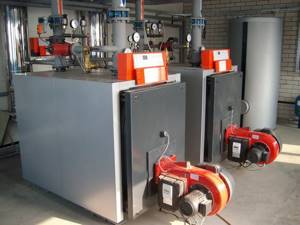
Both models are not the most powerful, but look at the coolant parameters. They meet industrial requirements. In any case, for small industries or for heating a small village, this is the best option.
STG-Classic
It should be noted that this is a modular boiler consisting of several cast iron compartments. Its productivity is 400 kW. Outlet coolant temperature: 95-115 °C, inlet: 50-70 °C. The ratio is optimal. The coolant pressure in the system is 6 atm.
The volume of the water tank is 50 liters (not very large), while 30 tons of water passes through it per hour. But this is already an excellent indicator. That is, with a minimum volume, the boiler can produce a large amount of coolant. True, at the same time it consumes almost 50 cubic meters of gas. And one more point - the unit will operate normally if gas with a constant pressure of 2 atm is supplied to its burner.
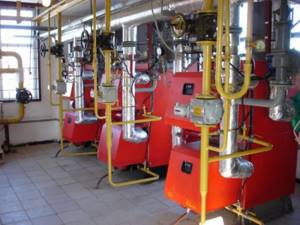
The STG-Classic boiler is small in size and weighs only half a ton. Like all industrial boilers, it is volatile, that is, it is connected to the electrical network.
